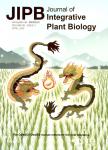Molecular regulation of sucrose catabolism and sugar transport for development~ defence and phloem function
Molecular regulation of sucrose catabolism and sugar transport for development,defence and phloem function作者机构:Australia-China Research Centre for Crop Improvement and School of Environmental and Life Sciences The University of NewcastleNSW 2308 Australia CSIRO Agriculture Canberra ACT 26oi Australia
出 版 物:《Journal of Integrative Plant Biology》 (植物学报(英文版))
年 卷 期:2017年第59卷第5期
页 面:322-335页
核心收录:
学科分类:0710[理学-生物学] 07[理学] 09[农学] 071007[理学-遗传学] 0901[农学-作物学] 090102[农学-作物遗传育种]
基 金:financially supported by Australia Research Council(DP110104931 DP120104148)to YLR
主 题:William J. Lucas University of California Davis USA
摘 要:Sucrose (Suc) is the major end product of photosynthesis in mesophyll cells of most vascular plants. It is loaded into phloem of mature leaves for long-distance translocation to non-photosynthetic organs where it is unloaded for diverse uses. Clearly, Suc transport and metabolism is central to plant growth and development and the functionality of the entire vascular system. Despite vast information in the literature about the physiological roles of individual sugar metabolic enzymes and transporters, there is a lack of systematic evaluation about their molecular regulation from transcriptional to post-translational levels. Knowledge on this topic is essential for understanding and improving plant development, optimizing resource distri- bution and increasing crop productivity. We therefore focused our analyses on molecular control of key players in Suc metabolism and transport, including: (i) the identifica- tion of promoter elements responsive to sugars and hormones or targeted by transcription factors and micro- RNAs degrading transcripts of target genes; and (ii) modulation of enzyme and transporter activities through protein-protein interactions and other post-translational modifications. We have highlighted major remaining questions and discussed opportunities to exploit current understanding to gain new insights into molecular control of carbon partitioning for improving plant performance.



